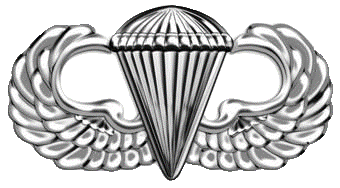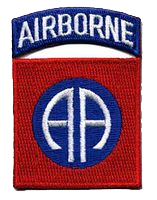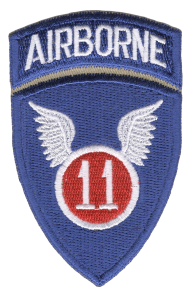Service Badges & Awards
SFC Gregorio M. Montano Sr.Military Career
Decorations
Badges
Awards
Units
Decorations
The Infantryman Shoulder Cord
The Infantryman Shoulder Cord – is a decoration presented only to infantry-qualified soldiers in the U.S. Army at the end of their Advanced Individual Training. The light blue cord is authorized to be worn over the right shoulder only for those with an infantry military occupational specialty such as 11A (infantry officers), 11B, or 11C.

Military Occupation Specialty (MOS)
- Airborne Infantry, 1945-1949 (WWII Germany & Japan Occupation Forces)
- Ordinance/Mechanic, 1956-1972 (Europe, US, Vietnam, Panama, US, 2nd Tour
Vietnam, US)
Badges
Airborne Parachutist Badge
The Army Airborne Parachutist Badge – is awarded to individuals who have completed the Basic Airborne Course of the Airborne School of the United States Army Infantry School at Fort Benning, Georgia. To graduate, a student must complete the three-phase course consisting of a ground phase, a tower phase, and a jump phase. By the end of the course, a student will have completed five jumps in varying jump configurations, from a “no load” jump all the way to a full combat load jump at night. SFC Montano reports that during his tenure, airborne parachutist training was a six week-long course.


Badges
Airborne Glider Badge
The Army Airborne Glider Badge – was a special skills badge of the United States Army awarded to personnel who had “been assigned or attached to a glider or airborne unit or to the Airborne Department of the Infantry School; satisfactorily completed a course of instruction, or participated in at least one combat glider mission into enemy-held territory. SFC Montano reports that during his tenure, airborne glider training was also a six-week-long course.
Badges
Expert Marksmanship Badge – Rifle
The Expert Marksmanship Badge – is an Army Weapons Qualification Badge is issued to soldiers upon completion of a weapons qualification course. Suspended from the badge are qualification bars that indicate the specific weapon(s) in which the soldier has qualified. Expert Rifle badge indicates that the soldier has hit at least 36 of 40 targets.


Badges
Driver and Mechanics Badge – Mechanic
The Driver and Mechanic Badge – is an Army special skill badge first created in July 1942. The badge is awarded to drivers, mechanics, and special equipment operators to denote the attainment of a high degree of skill in the operation and maintenance of motor vehicles.
Units
These are the units Gregorio served in during his tenure in the Army. Click each drop-down for more information.
82nd Airborne Division "All American"

The 82nd Airborne Division is an airborne infantry division of the United States Army specializing in parachute assault operations into denied areas[1] with a U.S. Department of Defense requirement to “respond to crisis contingencies anywhere in the world within 18 hours”.[2] Based at Fort Liberty, North Carolina, the 82nd Airborne Division is part of the XVIII Airborne Corps. The 82nd Airborne Division is the U.S. Army’s most strategically mobile division.[3]
The division was constituted, originally as the 82nd Division, in the National Army on 5 August 1917, shortly after the American entry into World War I. It was organized on 25 August 1917, at Camp Gordon, Georgia, and later served with distinction on the Western Front in the final months of World War I. Since its initial members came from all 48 states, the division acquired the nickname All-American, which is the basis for its “AA” on the shoulder patch. The division later served in World War II where, in August 1942, it was reconstituted as the first airborne division of the U.S. Army and fought in numerous campaigns during the war.
11th Airborne Division

The 11th Airborne Division (“Arctic Angels”[1]) is a United States Army airborne formation based in Alaska.
First activated on 25 February 1943, during World War II, it was held in reserve in the United States until June 1944 when it was transferred to the Pacific Theater where it saw combat in the Philippines. On 30 August 1945 the division was sent to southern Japan as part of the occupation force where it remained for four years. One parachute infantry regiment was detached for service in the Korean War, but on 30 June 1958 the division was inactivated.
11th Armored Cavalry "Black Horse" Regiment

The 11th Armored Cavalry Regiment (“Blackhorse Regiment”)[1] is a unit of the United States Army garrisoned at the Fort Irwin National Training Center in California. Although termed an armored cavalry regiment, it is being re-organized as a multi-component heavy brigade combat team.[citation needed] The regiment has served in the Philippine–American War, the Pancho Villa Expedition, World War II, the Vietnam War, Gulf War and Iraq War. The 11th ACR serves as the opposing force (OPFOR) for the Army and Marine task forces, and foreign military forces that train at Fort Irwin.
U.S. Army School of the Americas

The Western Hemisphere Institute for Security Cooperation (WHINSEC), formerly known as the School of the Americas,[2] is a United States Department of Defense school located at Fort Moore in Columbus, Georgia, renamed in the 2001 National Defense Authorization Act.
The institute was founded in 1946; by 2000, more than 60,000 Latin American military, law enforcement, and security personnel had attended the school. The school was located in the Panama Canal Zone until its expulsion in 1984.
1st Cavalry Division

The 1st Cavalry Division (“First Team”)[1] is a combined arms division and is one of the most decorated combat divisions of the United States Army.[2] It is based at Fort Cavazos, Texas. It was formed in 1921 and served during World War II, the Korean War, the Vietnam War, the Persian Gulf War, with the Stabilization Force in Bosnia-Herzegovina, in the Iraq War, in the War in Afghanistan as well as Operation Freedom’s Sentinel and Operation Inherent Resolve. As of July 2023, the 1st Cavalry Division is subordinate to III Armored Corps and is commanded by Major General Kevin D. Admiral.
The unit is unique in that it has served as a horseback cavalry division until 1943, an infantry division, an air assault division and an armored division during its existence.
Awards
Meritorious Service Medal (MSM)
The Meritorious Service Medal (MSM) is a military award presented to members of the United States Armed Forces who distinguished themselves by outstanding meritorious achievement or service to the United States subsequent to January 16, 1969. The MSM was previously awarded as a decoration for achievement during peacetime, but effective September 11, 2001 this decoration may also be bestowed in lieu of the Bronze Star Medal for meritorious achievement in a designated combat theater.

Army Commendation Medal
The Army Commendation Medal is awarded to members of the Armed Forces of the United States who, while serving in any capacity with the Army, distinguish themselves by heroism, outstanding achievement, or meritorious service.

Good Conduct Medal (GCM)
The Good Conduct Medal (GCM) is awarded for exemplary behavior, efficiency, and fidelity in active Federal military service. It is awarded on a selective basis to each Soldier who distinguishes himself from among his fellow Soldiers by their exemplary conduct, efficiency, and fidelity throughout a specified period of continuous enlisted active Federal military service, as outlined in chapter 4, AR 600-8-22.

More Details
• Bronze clasps indicate the second (two knots) through the fifth award (five knots).
Army of Occupation Medal
The Army of Occupation Medal is a military award of the United States military which was established by the United States War Department on 5 April 1946. The medal was created in the aftermath of the Second World War to recognize those who had performed occupation service in either Germany, Italy, Austria, Japan, or Korea.

More Details
- Campaign clasps were worn on the full-sized medal only with no corresponding device when wearing the Army of Occupation Medal as a ribbon on a military uniform.
- Germany clasp awarded for service in Germany (9 May 1945 to 5 May 1955)
- Japan clasp awarded for service in Japan (3 September 1945 to 27 April 1952)
World War II Victory Medal
The World War II Victory Medal was established by an Act of Congress on 6 July 1945 (Public Law 135, 79th Congress) and promulgated by Section V, War Department Bulletin 12, 1945. The Congressional authorization for the medal specified that it was to be awarded to any member of the United States military, including members of the armed forces of the Government of the Philippine Islands, who served on active duty, or as a reservist, between 7 December 1941 and 2 September 1945.

National Defense Service Medal (NDSM)
The National Defense Service Medal (NDSM) is a service award of the United States Armed Forces established by President Dwight D. Eisenhower in 1953. It was awarded to every member of the U.S. Armed Forces who served during any one of four specified periods of armed conflict or national emergency from June 27, 1950 through December 31, 2022.

Vietnam Service Medal (VSM)
The Vietnam Service Medal (VSM) was awarded to all members of the U.S. Armed Forces who served in Vietnam and its contiguous waters or airspace, from 3 July 1965 through 28 March 1973.

Republic of Vietnam Campaign Medal with Device (1960– )
The Republic of Vietnam Campaign Medal with Device (1960– ) was awarded by the South Vietnamese government to members of the South Vietnamese military for wartime service on March 24, 1966, to members of the U.S. military for support of operations in Vietnam.

